#mig31bm
Explore tagged Tumblr posts
Photo

Сверхзвуковой высотный всепогодный истребитель-перехватчик дальнего радиуса действия "МиГ-31БМ" ВВС России, Москва - Жуковский (Раменское), 2019 год. ©Фото: Alex S Supersonic high-altitude all-weather long-range fighter-interceptor MiG-31BM of the Russian Air Force, Moscow - Zhukovsky (Ramenskoye), 2019. #Aircraft #Fighter #Interceptor #MiG31BM #AirForce #Aviation #Zhukovsky #Ramenskoye #Самолет #Истребитель #Перехватчик #МиГ31БМ #ВВС #ВКС #Авиация #Жуковский #Раменское (at Аэродром Раменское) https://www.instagram.com/p/B3uVMC6oD6T/?igshid=prdmlp2pfubo
#aircraft#fighter#interceptor#mig31bm#airforce#aviation#zhukovsky#ramenskoye#самолет#истребитель#перехватчик#миг31бм#ввс#вкс#авиация#жуковский#раменское
0 notes
Link
Russian military presence in the Arctic 'absolutely necessary,' says Kremlin Responding to CNN reporting about satellite images showing huge Russian military build-up in the Arctic, Peskov said “the Commander-in-Chief [Putin] really considers the Russian military presence in the Arctic to be an absolutely necessary element of military development.” “The Arctic zone is a very important region of the Russian Federation, which applies both to our borders and to our special economic zone. The economic potential is growing from year to year, you know that there are general plans for national development in the Arctic zone, and all this is being consistently implemented,” Peskov said. Satellite images provided to CNN by space technology company Maxar detail a stark and continuous build-up of Russian military bases and hardware on the country’s Arctic coastline, together with underground storage facilities likely for new high-tech weapons and the the Poseidon 2M39 torpedo. This unmanned stealth torpedo is powered by a nuclear reactor and intended by Russian designers to sneak past coastal defenses — like those of the US — on the sea floor. The Russian hardware in the High North area includes bombers and MiG31BM jets, and new radar systems close to the coast of Alaska. “Nobody wants to see the Arctic as a region become militarized,” Pentagon spokesman John Kirby said on Monday as he addressed the reports of the build-up of Russian military capacities in the Arctic. “We obviously recognize that the region is key terrain that’s vital to our own homeland defense, and as a potential strategic corridor between the Indo Pacific Europe and the homeland, which would make it vulnerable to expanded competition, if you will,” he said. “We’re committed to protecting your US national security interests in the Arctic by upholding a rules based order in the region, particularly through our network of Arctic allies and partners who share the same mutual interest that we do in exactly that order,” Kirby added. In regards to those concerns, Peskov said “it should not be forgotten that America itself has never renounced its military presence in the Arctic zone, has never weakened its attention to the Arctic zone.” The Russian build-up has been matched by NATO and US troop and equipment movements. American B-1 Lancer bombers stationed in Norway’s Ørland air base have recently completed missions in the eastern Barents Sea, for example. The US military’s stealth Seawolf submarine was acknowledged by US officials in August as being in the area. Source link Orbem News #absolutely #Arctic #Kremlin #military #presence #Russian
0 notes
Text
Check out New Post published on Ọmọ Oòduà
New Post has been published on http://ooduarere.com/news-from-nigeria/world-news/russian-aircraft-tanks/
Making sense of a few rumors about Russian aircraft, tanks, and aircraft carriers
[This analysis was written for the Unz Review]
Russians are typically good at some things, and not so good at others. One of the things which Russian politicians are still terrible at, is avoiding self-inflicted PR disasters. Remember how Russian officials mismanaged the entire topic of “S-300s for Syria” (if not, then check out “part six” of this analysis)? Something similar is happening again, but this time with the procurement of new advanced and expensive weapons systems.
We have all seen the “Russia is canceling the Su-57!” and “Russia cannot afford the new Armata T-14 tank!” headlines. Pretty soon I expect to see something along the lines of “US sanctions force Putin to abandon the XXXX” (fill the blank with whatever weapon system you want). So is there any truth to any of that?
Well, yes and no.
Aircraft and main battle tanks
What is true is that Russian officials have been way too eager to declare that the Russian military will soon have many weapons systems much superior to anything produced in the West. Alas, these same officials rarely bothered explaining where, why, when and how many of these weapons systems actually would be deployed. That kind of ambiguous message makes it look like Russia is zig-zagging (again!). Perfect example: Russia deploys 4 Su-57s to Syria and then appears to more or less cancel or, at least, dramatically reduce the procurement of this weapons system. The reality is both much simpler and a little more complex. And to explain what is taking place we need to first understand the difference in military procurement in the West and in Russia.
In the West, the main goal of any procurement of any weapons system is the transfer of as much money as possible from the government to the pockets of the private individuals controlling the Military-Industrial Complex. Put differently, Western force planning (especially in the US) is not threat or mission-driven, but profit driven. And while some outrageously expensive weapons systems do get canceled (like the Boeing–Sikorsky RAH-66 Comanche attack helicopter), other even more expensive and poorly designed ones remain funded (such as the F-35). This is the kind of situation only a fantastically corrupt country with no real threat to itself can afford. In contrast, Russia is far less corrupt and has potential enemies right across most of her borders.
In contrast, Russian force planning is threat/mission driven. This means that before the Russian military decides that it needs X number of Su-57 or T-14s it has to make the case that there is a threat which only Su-57s and T-14s can counter (or, at least, that it makes more sense – human, economic or tactical – to use new systems)
During the Cold War, the general rule (there were exceptions, of course!) was that the US was typically the first side to deploy a new technology/capability which the Soviets then studied before developing a counter-capability once the strengths and weaknesses of the new US technologies/capabilities were fully understood. The price to pay for that method was that the Soviets were usually one step behind the US in deploying a new technology. The main advantage of this dynamic for the Soviets was that their weapons systems typically ended up being both cheaper and superior. A good example of this kind of dynamic is the development of the Su-27 in response to the US development of the F-15 or the development of the Akula-class SSN in response to the Los Angeles-class SSN by the USN.
Today the situation is quite different. If you compare Russian and western weapons systems (say, the latest versions of the Su-35/Su-30s vs the latest versions of the F-15s/16s/18s or the T-90/T-72B3/B3M vs the Abrams/Leopard MBTs) you realize that the current Russians systems are at least as good as their US/EU counterparts, if not better. This happened because with the official end of the Cold War US/EU force planners decided to waste money on hugely expensive weapons systems instead of modernizing their aging aircraft or tanks. After all, 20-30-year-old tanks and aircraft were more than adequate to deal with such “threats” as Iraq or Yugoslavia, so why waste the money: nobody expected Russia to be able to rebound as fast as she did.
All this begs the question of what threats the Su-57s or T-14s were supposed to deal with? Logically this threat would have to be a threat which already existing Su-35s or modernized T-72/80/90s could not deal with. Can such threats be identified? Probably yes, both in the West and, in the case of aircraft, in the East. But how big (in terms of numbers) this threat will actually be is a huge question. For example, I would argue that the only strategic direction in which the deployment of T-14 would make sense is the West, specifically for the First Guards Tank Army which would have to fight NATO in case of a war. And even in this case, there is an optimal mix of old/new MBTs inside the two divisions composing the backbone of this Army which would make more sense than replacing all their current MBTs with T-14s (this will be especially true if a 152mm gun version of the Armata is ever deployed). As for deploying the T-14s to the South or East of Russia, it would make no sense at all since no opposing force in these directions would have armor superior to the Russians. In the case of air-power, this issue is not so much a geographical one (tactical air-power can be rapidly moved from one location to another one) as it is the number of F-22s/F-35s/(X-2s?) the US and its allies could deploy against Russia (assuming air-to-air refueling and that the F-35 actually works as advertised).
[Sidebar: in reality only comparing tactical aircraft to tactical aircraft and MBTs to other MBTs is a gross oversimplification; in the real world you would have to compare the full spectrum of capabilities of both sides, such as MBTs vs anti-tank weapons or attack helicopters (in the case or air combat this would be even much more complicated), so I kept it simple just for illustration purposes.]
For the foreseeable future, the threat to Russia will come from the latest iterations of the F-16/15/18s in which case the Su-35s/Su-30SM/Mig-25SMT/MiG-35/MiG31BM will be more than enough to deal with that threat, especially with their new radar+missile combos. And for a more advanced threat, a combination of Su-57s and already existing generation 4++ aircraft makes more sense than trying to deploy thousands of 5th generation aircraft (which is what the US is currently doing).
Finally, there is the issue of exports. While exports can help finance the costs of new and very pricey systems, the export potential of already existing Russian systems is much bigger than the one of recently deployed systems. Originally, the Russians had hoped to basically co-develop the Su-57 with India, but the pressures of the very powerful pro-US lobby inside India combined with differences in design philosophy and technical requirements have made the future of this collaboration rather uncertain. Of course, there is China, but the Chinese also have to ask themselves the question of how many Su-57 they would really want to purchase from Russia, especially considering that they have already purchased many Su-35s and are still working on their own 5th generation aircraft.
The Cold War years illustrate how the Soviet Union dealt with this problem: both the advanced and expensive Su-27 and the cheaper, but still very effective, MiG-29 were developed and deployed more or less simultaneously (along with some very good missiles) and while the Sukhoi was a much more complex aircraft with a much bigger upgrade potential, the MiG was cheap, fantastically maneuverable and superbly adapted to it’s “front line fighter” mission in spite of not even having fly-by-wire! It is therefore hardly surprising that Russian force planners today would like similar options.
Which makes me wonder which major weapon procurement program will be “mothballed” next?
Russian aircraft carriers and aircraft-carrying assault ships
My vote goes for the much announced Russian Project 23000 “Storm” super aircraft carrier (check out this article by Andrei Martyanov on this topic). Without going into the issue of whether Russia needs aircraft carriers and, if yes, what kind exactly (I personally think that the Russian Navy has more important programs to spend money on), it strikes me as extremely premature to declare, in 2018, that Russia plans to deploy not one, but three or even four (!), such super aircraft carriers. The reality is that for the foreseeable future budgetary and technological constraints will only allow Russia to build one carrier and that that carrier will probably be what Martyanov calls a “niche” carrier. Oh sure, if the Russian military budget was anywhere near the US one and if the Russian MIC was anywhere near as corrupt as the one of the United States, three or four carriers would be possible, but as long as every ruble has to be accounted for and justified through a comparison of opportunity costs and mission requirements, this will not happen. I am still waiting to see if the Russian Navy will ever get the promised “Priboi” universal assault ships to replace the French “Mistrals” and, if that happens, what the Priboi-class will actually look like, how they will be equipped and when they will be accepted for operation by the Russian Navy.
Conclusion: less hype, more common sense please!
Russia has, and will developed, new, expensive and advanced weapons systems simply because she needs to maintain the technological and industrial capabilities to keep up with the evolving threats. You cannot build a 6th generation fighter if you have not ever developed a 5th-generation one. However, Russia has had to tackle the immensely complicated task of replacing all the systems components previously developed abroad (say, in the Ukraine) with indigenous ones. Following western sanctions, it has become absolutely self-evident that Russian weapons systems must be built exclusively with Russian technologies and components (which, by the way, their US counterparts are not). While Russia did benefit from the brain-drain from the Ukraine (and other ex-Soviet republics) which saw many highly skilled engineers and scientists leave following the collapse of the Ukrainian industrial base, Russian resources have still been severely stretched by the urgent need to create a truly autonomous military-industrial complex, most of it ex nihilo. Furthermore, there are still technological and industrial bottlenecks which need to be dealt with before Russian can produce her new weapon systems in sufficient numbers (that is especially true of large warships). As of today, the goal of full “import substitution” has not been fully realized, even if immense progress towards it has already been made.
The one thing Russia could – and should – immediately do is learn how to present a consistent and balanced message to her public opinion. Every time loud and triumphant declarations are followed by more sober assessments, the anti-Putin forces in Russia (and abroad) scream to high heavens about “Putin” having promised the sky and delivered nothing (again, the entire mess with S-300s for Syria is a perfect example of this). So yes, Russia public relations still often suck. But there is nothing wrong with Russian force planning.
The Saker
0 notes
Photo

Сверхзвуковой высотный всепогодный истребите��ь-перехватчик дальнего радиуса действия "МиГ-31БМ" ВВС России, 2019 год. ©Фото: Андрей Шматко Supersonic all-weather all-weather fighter-interceptor of the long-range MiG-31BM of the Russian Air Force, 2019. #Aircraft #Fighter #Interceptor #MiG31BM #AirForce #Aviation #Самолет #Истребитель #Перехватчик #МиГ31БМ #ВВС #ВКС #Авиация https://www.instagram.com/p/B3jbULnIRaD/?igshid=1p7exxcuz1ksc
#aircraft#fighter#interceptor#mig31bm#airforce#aviation#самолет#истребитель#перехватчик#миг31бм#ввс#вкс#авиация
0 notes
Photo

Сверхзвуковой высотный всепогодный истребитель-перехватчик дальнего радиуса действия "МиГ-31БМ" ВКС России, 2018 год. ©Фото: Дмитрий Supersonic all-weather all-weather fighter-interceptor of the long-range MiG-31BM VKS of Russia, 2018. #Aircraft #Fighter #Interceptor #MiG31BM #AirForce #Aviation #Самолет #Истребитель #Перехватчик #МиГ31БМ #ВВС #ВКС #Авиация https://www.instagram.com/p/B3g0_GfozC1/?igshid=1p1rw1qgp8fp6
#aircraft#fighter#interceptor#mig31bm#airforce#aviation#самолет#истребитель#перехватчик#миг31бм#ввс#вкс#авиация
0 notes
Photo

Сверхзвуковой высотный всепогодный истребитель-перехватчик дальнего радиуса действия "МиГ-31БМ" ВВС России, имя собственное "Павел Чупиков", 2019 год. ©Фото: Макс С Supersonic high-altitude all-weather long-range fighter-interceptor MiG-31BM of the Russian Air Force, proper name Pavel Chupikov, 2019. #Aircraft #Fighter #Interceptor #MiG31BM #AirForce #Aviation #Самолет #Истребитель #Перехватчик #МиГ31БМ #ВВС #ВКС #Авиация https://www.instagram.com/p/B3d9CQYITnY/?igshid=13xensfn13wp
#aircraft#fighter#interceptor#mig31bm#airforce#aviation#самолет#истребитель#перехватчик#миг31бм#ввс#вкс#авиация
0 notes
Photo

Сверхзвуковой высотный всепогодный истребитель-перехватчик дальнего радиуса действия "МиГ-31БМ" ВВС России, 2019 год. ©Фото: Макс С Supersonic high-altitude all-weather long-range fighter-interceptor MiG-31BM of the Russian Air Force, 2019. #Aircraft #Fighter #Interceptor #MiG31BM #AirForce #Aviation #Самолет #Истребитель #Перехватчик #МиГ31БМ #ВВС #ВКС #Авиация https://www.instagram.com/p/B3cIv3ToGls/?igshid=1c9ddzygrmoss
#aircraft#fighter#interceptor#mig31bm#airforce#aviation#самолет#истребитель#перехватчик#миг31бм#ввс#вкс#авиация
0 notes
Photo

Сверхзвуковой высотный всепогодный истребитель-перехватчик дальнего радиуса действия "МиГ-31БМ" ВВС России, 2019 год. ©Фото: Сергей Чайковский Supersonic high-altitude all-weather long-range fighter-interceptor MiG-31BM of the Russian Air Force, 2019. #Aircraft #Fighter #Interceptor #MiG31BM #AirForce #Aviation #Самолет #Истребитель #Перехватчик #МиГ31БМ #ВВС #ВКС #Авиация https://www.instagram.com/p/B3KfwQOIDvN/?igshid=1syjwpx8xkc7s
#aircraft#fighter#interceptor#mig31bm#airforce#aviation#самолет#истребитель#перехватчик#миг31бм#ввс#вкс#авиация
0 notes
Photo
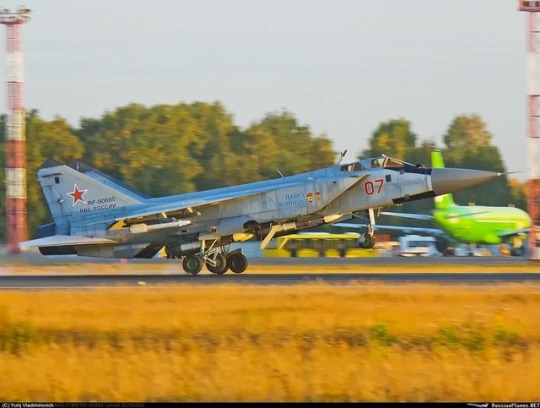
Сверхзвуковой высотный всепогодный истребитель-перехватчик дальнего радиуса действия "МиГ-31БМ" ВВС России, имя собственное "Павел Чупиков". Новосибирск - Толмачёво, 2019 год. ©Фото: NSK spotter Supersonic all-weather high-altitude all-weather fighter-interceptor MiG-31BM of the Russian Air Force, proper name Pavel Chupikov. Novosibirsk - Tolmachevo, 2019. #Aircraft #Fighter #Interceptor #MiG31BM #PavelChupikov #AirForce #Aviation #Novosibirsk #Tolmachevo #Самолет #Истребитель #Перехватчик #МиГ31БМ #ПавелЧупиков #ВВС #ВКС #Авиация #Новосибирск #Толмачёво (at Толмачёво) https://www.instagram.com/p/B3H84l2oXqd/?igshid=gpksz8mvf8d2
#aircraft#fighter#interceptor#mig31bm#pavelchupikov#airforce#aviation#novosibirsk#tolmachevo#самолет#истребитель#перехватчик#миг31бм#павелчупиков#ввс#вкс#авиация#новосибирск#толмачёво
0 notes
Photo
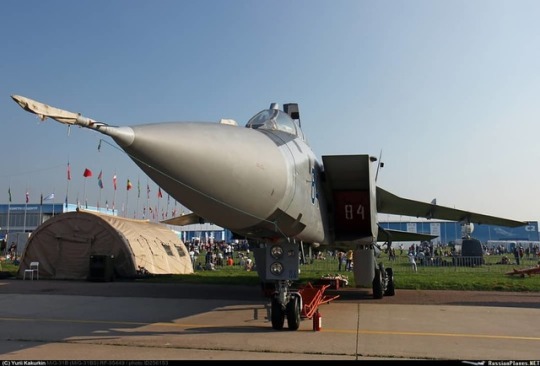
Сверхзвуковой высотный всепогодный истребитель-перехватчик дальнего радиуса действия "МиГ-31БМ" ВВС России, Москва - Жуковский (Раменское), 2019 год. ©Фото: Юрий Какуркин Supersonic all-weather all-weather fighter-interceptor of the long-range "MiG-31BM" of the Russian Air Force, Moscow - Zhukovsky (Ramenskoye), 2019. #Aircraft #Fighter #Interceptor #MiG31BM #AirForce #Aviation #Zhukovsky #Ramenskoye #Самолет #Истребитель #Перехватчик #МиГ31БМ #ВВС #ВКС #Авиация #Жуковский #Раменское (at Аэродром Раменское) https://www.instagram.com/p/B27BtrhAMaT/?igshid=1mf44etaxy4cw
#aircraft#fighter#interceptor#mig31bm#airforce#aviation#zhukovsky#ramenskoye#самолет#истребитель#перехватчик#миг31бм#ввс#вкс#авиация#жуковский#раменское
0 notes
Photo
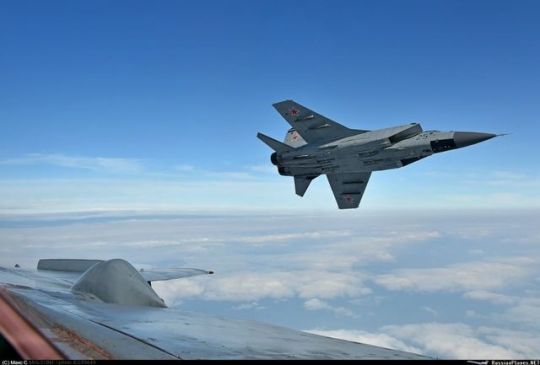
Сверхзвуковой высотный всепогодный истребитель-перехватчик дальнего радиуса действия "МиГ-31БМ" ВВС России, 2019 год. ©Фото: Макс С Supersonic all-weather all-weather fighter-interceptor of the long-range MiG-31BM of the Russian Air Force, 2019. #Aircraft #Fighter #Interceptor #MiG31BM #AirForce #Aviation #Самолет #Истребитель #Перехватчик #МиГ31БМ #ВВС #ВКС #Авиация https://www.instagram.com/p/B2t33umBqmC/?igshid=qdmzqafybmy8
#aircraft#fighter#interceptor#mig31bm#airforce#aviation#самолет#истребитель#перехватчик#миг31бм#ввс#вкс#авиация
0 notes
Photo
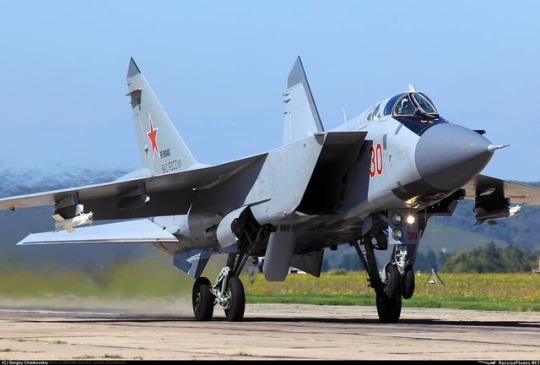
Сверхзвуковой высотный всепогодный истребитель-перехватчик дальнего радиуса действия МиГ-31БМ ВКС России, 2019 год. ©Фото: Сергей Чайковский Supersonic high-altitude all-weather fighter-interceptor of the long-range MiG-31BM VKS of Russia, 2019. #Aircraft #Fighter #Interceptor #MiG31BM #AirForce #Aviation #Самолет #Истребитель #Перехватчик #МиГ31БМ #ВВС #ВКС #Авиация https://www.instagram.com/p/B2rBkc4IR60/?igshid=1h3mtswddj3ag
#aircraft#fighter#interceptor#mig31bm#airforce#aviation#самолет#истребитель#перехватчик#миг31бм#ввс#вкс#авиация
0 notes
Photo
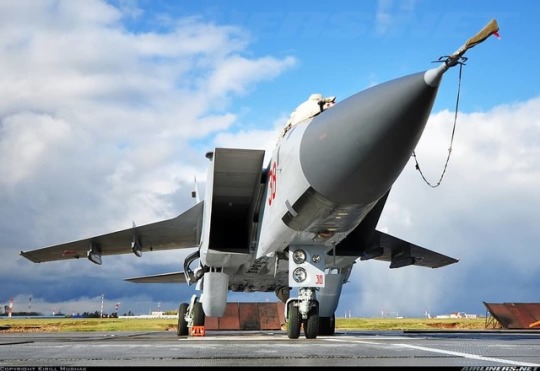
Сверхзвуковой высотный всепогодный истребитель-перехватчик дальнего радиуса действия МиГ-31БМ ВВС России, 2 октября 2013 г. ©Фото: Кирилл Мушак Ultrasonic high-altitude all-weather long-range fighter-interceptor MiG-31BM Russian Air Force, October 2, 2013. #Aircraft #Fighter #Interceptor #MiG31BM #AirForce #Aviation #Самолет #Истребитель #Перехватчик #МиГ31БМ #ВВС #ВКС #Авиация https://www.instagram.com/p/B2MrZcGoOMn/?igshid=spuh74wgvqsb
#aircraft#fighter#interceptor#mig31bm#airforce#aviation#самолет#истребитель#перехватчик#миг31бм#ввс#вкс#авиация
0 notes
Link
Russia is amassing unprecedented military might in the Arctic Weapons experts and Western officials have expressed particular concern about one Russian ‘super-weapon,’ the Poseidon 2M39 torpedo. Development of the torpedo is moving fast with Russian President Vladimir Putin requesting an update on a “key stage” of the tests in February from his defense minister Sergei Shoigu, with further tests planned this year, according to multiple reports in state media. The device is intended to deliver a warhead of multiple megatons, according to Russian officials, causing radioactive waves that would render swathes of the target coastline uninhabitable for decades. In November, Christopher A Ford, then assistant secretary of state for International Security and Non-Proliferation, said the Poseidon is designed to “inundate U.S. coastal cities with radioactive tsunamis.” An “onyx” anti-ship cruise missile launched by the Northern Fleet in Alexandra Land, near an Arctic “trefoil” base. Credit: Russian Ministry of Defense Experts agree that the weapon is “very real” and already coming to fruition. The head of Norwegian intelligence, Vice Admiral Nils Andreas Stensønes, told CNN that his agency has assessed the Poseidon as “part of the new type of nuclear deterrent weapons. And it is in a testing phase. But it’s a strategic system and it’s aimed at targets … and has an influence far beyond the region in which they test it currently.” Stensønes declined to give details on the torpedo’s testing progress so far. Satellite images provided to CNN by space technology company Maxar detail a stark and continuous build-up of Russian military bases and hardware on the country’s Arctic coastline, together with underground storage facilities likely for the Poseidon and other new high-tech weapons. The Russian hardware in the High North area includes bombers and MiG31BM jets, and new radar systems close to the coast of Alaska. The Russian build-up has been matched by NATO and US troop and equipment movements. American B-1 Lancer bombers stationed in Norway’s Ørland air base have recently completed missions in the eastern Barents Sea, for example. The US military’s stealth Seawolf submarine was acknowledged by US officials in August as being in the area. A senior State Department official told CNN: “There’s clearly a military challenge from the Russians in the Arctic,” including their refitting of old Cold War bases and build-up of new facilities on the Kola Peninsula near the city of Murmansk. “That has implications for the United States and its allies, not least because it creates the capacity to project power up to the North Atlantic,” the official said. Source: Satellite image ©2021 Maxar Technologies, Center for Strategic and International Studies (CSIS). Graphic: Henrik Pettersson, CNN The satellite images show the slow and methodical strengthening of airfields and “trefoil” bases — with a shamrock-like design, daubed in the red, white and blue of the Russian flag — at several locations along Russia’s Arctic coast over the past five years. The bases are inside Russian territory and part of a legitimate defense of its borders and coastline. US officials have voiced concern, however, that the forces might be used to establish de facto control over areas of the Arctic that are further afield, and soon to be ice-free. “Russia is refurbishing Soviet-era airfields and radar installations, constructing new ports and search-and-rescue centers, and building up its fleet of nuclear- and conventionally-powered icebreakers,” Lt. Col. Thomas Campbell, a Pentagon spokesman, told CNN. The 50 Let Pobedy (50 years of victory) icebreaker moving through the Arctic ice, said to be in January this year, in a first transit of the eastern seas in deep winter. Credit: Rosatom State Nuclear Energy Corporation “It is also expanding its network of air and coastal defense missile systems, thus strengthening its anti-access and area-denial capabilities over key portions of the Arctic,” he added. Campbell also noted the recent creation of a Quick Reaction Alert force at two Arctic airfields — Rogachevo and Anadyr — and the trial of one at Nagurskoye airfield last year. Satellite imagery from March 16 shows probable MiG31BMs at Nagurskoye for what is thought to be the first time, bringing a new capability of Russian stealth air power to the far north. High-tech weapons are also being regularly tested in the Arctic area, according to Russian officials quoted in state media and Western officials. Campbell added that in November, Russia claimed the successful test of the ‘Tsirkon’ anti-ship hypersonic cruise missile. A Russian army demonstration video of its new ski sled for the Arctic. Credit: Russian Ministry of Defense The Tsirkon and the Poseidon are part of a new generation of weapons pledged by Putin in 2018 as strategic game changers in a fast-changing world. At the time US officials scorned the new weapons as technically far-fetched and improbable, yet they appear to be nearing fruition. The Norwegian intelligence chief Stensønes told CNN the Tsirkon as a “new technology, with hypersonic speeds, which makes it hard to defend against.” On Thursday, Russian state news agency TASS cited a source in the military industrial complex as saying there had been another successful test of the Tsirkon from the Admiral Gorshkov warship, saying all four test rockets had hit their target, and that another more advanced level of tests would begin in May or June. The climate emergency has removed many of Russia’s natural defenses to its north, such as walls of sheet ice, at an unanticipated rate. “The melt is moving faster than scientists predicted or thought possible several years ago,” said the senior State Department official. “It’s going to be a dramatic transformation in the decades ahead in terms of physical access.” Source: Satellite image ©2021 Maxar Technologies, Center for Strategic and International Studies (CSIS). Graphic: Henrik Pettersson, CNN US officials also expressed concern at Moscow’s apparent bid to influence the “Northern Sea Route” — a shipping lane that runs from between Norway and Alaska, along Russia’s northern coast, across to the North Atlantic. The ‘NSR’ potentially halves the time it currently takes shipping containers to reach Europe from Asia via the Suez Canal. Russia’s Rosatom state nuclear company released elaborately produced drone video this February of the ‘Christophe de Margerie’ tanker completing an eastern route across the Arctic in winter for the first time, accompanied by the ’50 Let Pobedy’ nuclear icebreaker for its journey in three of the six Arctic seas. Campbell said Russia sought to exploit the NSR as a “major international shipping lane,” yet voiced concern at the rules Moscow was seeking to impose on vessels using the route. “Russian laws governing NSR transits exceed Russia’s authority under international law,” the Pentagon spokesman said. “They require any vessel transiting the NSR through international waters to have a Russian pilot onboard to guide the vessel. Russia is also attempting to require foreign vessels to obtain permission before entering the NSR.” The senior State Department official added: “The Russian assertions about the Northern Sea Route is most certainly an effort to lay down some rules of the road, get some de facto acquiescence on the part of the international community, and then claim this is the way things are supposed to work.” Elizabeth Buchanan, lecturer of Strategic Studies at Deakin University, Australia, said that “basic geography affords Russia the NSR which is increasingly seeing thinner ice for more of the year making it commercially viable to use as a transport artery. This might yet transform global shipping, and with it the movements of 90+% of all goods globally.” The State Department official believes the Russians are mostly interested in exporting hydrocarbons — essential to the country’s economy — along the route, but also in the resources being uncovered by the fast melt. The flexing of their military muscles in the north — key to Moscow’s nuclear defense strategy, and also mostly on Russian coastal territory — could be a bid to impose their writ on the wider area, the official said. “When the Russians are testing weapons, jamming GPS signals, closing off airspace or sea space for exercises, or flying bombers over the Arctic along the airspace of allies and partners, they are always trying to send a message,” the official added. Among these new weapons is the Poseidon 2M39. The plans for this torpedo were initially revealed in an apparently purposeful brandishing of a document discussing its capabilities by a Russian general in 2015. It was subsequently partially dismissed by analysts as a ‘paper tiger’ weapon, meant to terrify with its apocalyptic destructive powers that appear to slip around current treaty requirements, but not to be successfully deployed. Yet a series of developments in the Arctic, including, according to Russian media reports, the testing of up to three Russian submarines designed to carry the stealth weapon, which has been suggested to be 20 meters long, have now led analysts to consider the project real and active. The Belgorod, a key submarine intended to be armed with the torpedo, will undergo important testing in May, according to a TASS report, although officials in the report stressed that it would not be related to the Poseidon’s development. Russia insists motives are peaceful and economic Russia’s foreign ministry declined to comment, yet Moscow has long maintained its goals in the Arctic are economic and peaceful. A March 2020 document by Kremlin policymakers presented Russia’s key goals in an area behind 20% of its exports and 10% of its GDP. The strategy focuses on ensuring Russia’s territorial integrity and regional peace. It also expresses the need to guarantee high living standards and economic growth in the region, as well as developing a resource base and the NSR as “a globally competitive national transport corridor.” Putin regularly extols the importance of Russia’s technological superiority in the Arctic. In November, during the unveiling of a new icebreaker in St. Petersburg, the Russian President said: “It is well-known that we have a unique icebreaker fleet that holds a leading position in the development and study of Arctic territories. We must reaffirm this superiority constantly, every day.” Putin said of a submarine exercise last week in which three submarines surfaced at the same time in the polar ice: “The Arctic expedition … has no analogues in the Soviet and the modern history of Russia.” Manash Protim Boruah, a submarine expert at Jane’s Fighting Ships, said: “The reality of the weapon is clear. You can absolutely see development around the torpedo, which is happening. There is a very good probability that the Poseidon will be tested, and then there is a danger of it polluting a lot. Even without a warhead, but definitely with just a nuclear reactor inside.” Boruah said some of the specifications for the torpedo leaked by the Russians were optimistic and doubted it could reach a speed of 100 knots (around 115 miles per hour) with a 100MW nuclear reactor. He added that at such a speed, it would probably be detected quite easily as it would create a large acoustic signature. “Even if you tone it down from the speculation, it is still quite dangerous,” he said. Source: Satellite image ©2021 Maxar Technologies, Center for Strategic and International Studies (CSIS). Graphic: Henrik Pettersson, CNN Boruah added that the construction of storage bays for the Poseidon, probably around Olenya Guba on the Kola Peninsula, were meant to be complete next year. He also expressed concerns about the Tsirkon hyper-sonic missile that Russia says it has tested twice already, which at speeds of 6 to 7 Mach would “definitely cause a lot of damage without a particularly having big warhead itself.” Katarzyna Zysk, professor of international relations at the state-run Norwegian Institute for Defence Studies, said the Poseidon was “getting quite real,” given the level of infrastructure development and testing of submarines to carry the torpedo. “It is absolutely a project that will be used to scare, as a negotiation card in the future, perhaps in arms control talks,” Zysk said. “But in order to do so, it has to be credible. This seems to be real.” Stensønes also raised the concern that testing such nuclear weapons could have serious environmental consequences. “We are ecologically worried. This is not only a theoretical thing: in fact, we have seen serious accidents in the last few years,” he said, referring to the testing of the Burevestnik missile which was reported to have caused a fatal nuclear accident in 2019. “The potential of a nuclear contamination is absolutely there.” Source link Orbem News #amassing #Arctic #military #Russia #unprecedented
0 notes